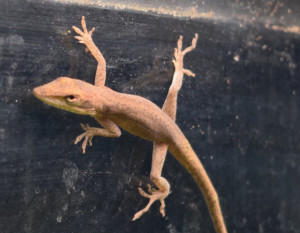I’ll leave this to others to comment (and thanks for the contributor who sent it in):
 Sally Mabon and her kindergartener, Faye, found an unexpected surprise last week when they unwrapped a bundle of tatsoi greens: a 3-inch lizard.
Sally Mabon and her kindergartener, Faye, found an unexpected surprise last week when they unwrapped a bundle of tatsoi greens: a 3-inch lizard.
It was cold and lifeless after having survived in the refrigerator for days, but is now thriving after some warmth and moisture.
The following day, Faye brought the critter to Riverside Elementary School, where it has become a mascot of sorts for teacher Mark Eastburn’s science lab.
“Interesting things can happen when you’re working as a science teacher,” he said. “We set up a little cage for it. It really came back amazingly well.”
While some of his fellow teachers were disgusted to hear that a lizard might be lurking in their salad greens, Eastburn said the lizard can teach them a couple of lessons: that organic food is safe for even the smallest of creatures, and that during the cold months, fresh fruits and vegetables need to come from warmer regions.
He said green anole lizards live in the southeastern United States, from Texas to North Carolina.
The lizard, nicknamed “Green Fruit Loop” by the kindergarteners, traveled from Florida.
“It probably has some moderate adaptation to the cold which is why it made it through,” Eastburn said.
Mabon bought the tatsoi from Whole Earth Center, a Princeton natural foods store whose produce is 100 percent organic (marketed that way).
Mike Atkinson, the store’s produce manager, said the lizard’s survival is a testament to organic food, which is generally grown without synthetic pesticides or fertilizers.
“I don’t think the lizard would’ve made it in a conventional, non-organic box,” he said. “It might normally surprise or freak out conventional shoppers, but the majority of organic shoppers realize that produce is grown on a farm and there’s lots of bugs and animals that live on a farm too. It shouldn’t be a surprise that one here and there makes it to the produce shelf.”
Eastburn has been teaching about DNA so he said it makes sense that the green anole lizard — the first reptile to have its genome sequenced — has now found a new home in the lab.
“It’s a really fitting mascot for our science lab,” he said.
